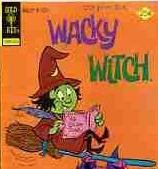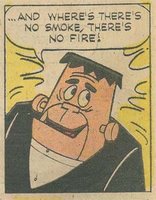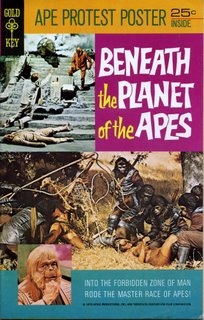Any good PopCereal kid worth his Sugar Smacks will surely recognize that familiar Gold Key comic book logo. For Mr. Miller here, those Gold Key treasures were like Saturday morning comic books, with all the bubblicious goodness of your favorite retro-cartoons. To sweeten the cereal bowl, many of the titles put out under Gold Key in the 70s were from the Saturday morning stable of cartoons, such as The Amazing Chan and the Chan Clan, Wacky Races, and of course Scooby Doo.
the gold key story The Western Printing and Lithographing Co. -- headed up by Disney marketing genius Herman "Kay" Kamen -- built a solid reputation putting out comic book versions of familiar newspaper comic strips. Using his pull at his former employee Walt Disney Studios, Kamen acquired the rights to characters from Disney cartoons in 1939. Soon he snatched up the rights to characters from Warner Bros., Hanna-Barbera and Walter Lantz, as well, and, along with adaptations of popular movies and TV shows, released them all in comic book form through Dell. These comic books experienced tremendous sales, but when the contract with Dell expired in 1962, the WPLC launched their own imprint -- Gold Key.
The Western Printing and Lithographing Co. -- headed up by Disney marketing genius Herman "Kay" Kamen -- built a solid reputation putting out comic book versions of familiar newspaper comic strips. Using his pull at his former employee Walt Disney Studios, Kamen acquired the rights to characters from Disney cartoons in 1939. Soon he snatched up the rights to characters from Warner Bros., Hanna-Barbera and Walter Lantz, as well, and, along with adaptations of popular movies and TV shows, released them all in comic book form through Dell. These comic books experienced tremendous sales, but when the contract with Dell expired in 1962, the WPLC launched their own imprint -- Gold Key.
 Throughout the 60s and early 70s, Dell grew in popularity, and with sales in the millions they created their own original charactersand titles, such as Turok, Son of Stone; Wacky Witch; and Space Family Robinson (which was to be the pre-cursor and inspiration to Lost in Space). But by the 80s the comic book biz, in general, was in a slump, and Gold Key couldn't keep sales up. They made a last ditch attempt to increase the visibility of their titles by marketing themselves in non-traditional outlets, like toy stores. But by 1981, Gold Key was done. What titles were left over from Gold Key were put out under the Whitman imprint (mostly known for coloring books), and Gold Key became a thing of PopCereal past. Ironically, with a licensing genius like Kay Kamen as the company's creator, Gold Key failed to license their own original characters. So with the eventual demise of Whitman comics in 1984, kooky characters like Baby Snoots and The Little Monsters were gone forever.
Throughout the 60s and early 70s, Dell grew in popularity, and with sales in the millions they created their own original charactersand titles, such as Turok, Son of Stone; Wacky Witch; and Space Family Robinson (which was to be the pre-cursor and inspiration to Lost in Space). But by the 80s the comic book biz, in general, was in a slump, and Gold Key couldn't keep sales up. They made a last ditch attempt to increase the visibility of their titles by marketing themselves in non-traditional outlets, like toy stores. But by 1981, Gold Key was done. What titles were left over from Gold Key were put out under the Whitman imprint (mostly known for coloring books), and Gold Key became a thing of PopCereal past. Ironically, with a licensing genius like Kay Kamen as the company's creator, Gold Key failed to license their own original characters. So with the eventual demise of Whitman comics in 1984, kooky characters like Baby Snoots and The Little Monsters were gone forever.
the little monsters
 With the 60s monster craze in full force, Mr. Miller took to everything creature related like Dracula to a blood bank. And to add more voltage to his neck bolts came the Gold Key comic book The Little Monsters, a gruesome clan of monster misfits who lived in a creepy castle and who slept on beds of nails. Following on the rotted heels of cartoons like Milton the Monster and Melvin Monster, but knocking on the crypt door before such TV notables as The Addams Family and The Munsters, The Little Monsters were unleashed upon the public within an issue of The Three Stooges (#17 to be exact). From then on Mr. Miller here was hooked on the misadventures of the monster kiddies 'Orrible Orvie and Awful Annie Monster, and their monstrous parents Mildew and Demonica.
With the 60s monster craze in full force, Mr. Miller took to everything creature related like Dracula to a blood bank. And to add more voltage to his neck bolts came the Gold Key comic book The Little Monsters, a gruesome clan of monster misfits who lived in a creepy castle and who slept on beds of nails. Following on the rotted heels of cartoons like Milton the Monster and Melvin Monster, but knocking on the crypt door before such TV notables as The Addams Family and The Munsters, The Little Monsters were unleashed upon the public within an issue of The Three Stooges (#17 to be exact). From then on Mr. Miller here was hooked on the misadventures of the monster kiddies 'Orrible Orvie and Awful Annie Monster, and their monstrous parents Mildew and Demonica.
 Issue #12 (1970) finds our frightening fiends in all sorts of monster sitcom-like trouble. The generation gap hits the Monster household when Scarella, the cute "scream-aged" ghost next door starts dating, then a robotic witch comes to life to stir up trouble, and finally little 'Orrible Orvie comes up with a perfectly demented solution to help his Dad, Mildew, build a moat around the castle. Also, there's the dimwitted tale of a criminal Bat, named Batty, as well as some jokes, riddles and scary tales... Oh, and some really cool 70s style comic book ads.
Issue #12 (1970) finds our frightening fiends in all sorts of monster sitcom-like trouble. The generation gap hits the Monster household when Scarella, the cute "scream-aged" ghost next door starts dating, then a robotic witch comes to life to stir up trouble, and finally little 'Orrible Orvie comes up with a perfectly demented solution to help his Dad, Mildew, build a moat around the castle. Also, there's the dimwitted tale of a criminal Bat, named Batty, as well as some jokes, riddles and scary tales... Oh, and some really cool 70s style comic book ads.
 Download and read issue #12
Download and read issue #12
 The Amazing Chan and the Chan Clan was a Saturday Morning favorite of Mr. Miller's. The show premiered in 1973, featuring not only the popular literary detective Charlie Chan, but his entire Chan brood. It was the first time that Chan was animated, but more importantly, it was the first time that Chan -- who is Chinese -- was was ever portrayed by an Asian actor. The previous film versions featured white actors with make-up. Keye Luke, who you may recognize as Master Po from the King Fu series, played the voice of Chan. And joining him was another popular 70s name, Jodie Foster as Anne Chan the baseball cap wearing tomboy.
The Amazing Chan and the Chan Clan was a Saturday Morning favorite of Mr. Miller's. The show premiered in 1973, featuring not only the popular literary detective Charlie Chan, but his entire Chan brood. It was the first time that Chan was animated, but more importantly, it was the first time that Chan -- who is Chinese -- was was ever portrayed by an Asian actor. The previous film versions featured white actors with make-up. Keye Luke, who you may recognize as Master Po from the King Fu series, played the voice of Chan. And joining him was another popular 70s name, Jodie Foster as Anne Chan the baseball cap wearing tomboy. In 1973 Gold Key started printing the exploits of the junior sleuth. Here you have your own pdf version of the #1 issue of The Amazing Chan and the Chan Clan
In 1973 Gold Key started printing the exploits of the junior sleuth. Here you have your own pdf version of the #1 issue of The Amazing Chan and the Chan Clan





 The Western Printing and Lithographing Co. -- headed up by Disney marketing genius Herman "Kay" Kamen -- built a solid reputation putting out comic book versions of familiar newspaper comic strips. Using his pull at his former employee Walt Disney Studios, Kamen acquired the rights to characters from Disney cartoons in 1939. Soon he snatched up the rights to characters from Warner Bros., Hanna-Barbera and Walter Lantz, as well, and, along with adaptations of popular movies and TV shows, released them all in comic book form through Dell. These comic books experienced tremendous sales, but when the contract with Dell expired in 1962, the WPLC launched their own imprint -- Gold Key.
The Western Printing and Lithographing Co. -- headed up by Disney marketing genius Herman "Kay" Kamen -- built a solid reputation putting out comic book versions of familiar newspaper comic strips. Using his pull at his former employee Walt Disney Studios, Kamen acquired the rights to characters from Disney cartoons in 1939. Soon he snatched up the rights to characters from Warner Bros., Hanna-Barbera and Walter Lantz, as well, and, along with adaptations of popular movies and TV shows, released them all in comic book form through Dell. These comic books experienced tremendous sales, but when the contract with Dell expired in 1962, the WPLC launched their own imprint -- Gold Key. Throughout the 60s and early 70s, Dell grew in popularity, and with sales in the millions they created their own original charactersand titles, such as Turok, Son of Stone; Wacky Witch; and Space Family Robinson (which was to be the pre-cursor and inspiration to Lost in Space). But by the 80s the comic book biz, in general, was in a slump, and Gold Key couldn't keep sales up. They made a last ditch attempt to increase the visibility of their titles by marketing themselves in non-traditional outlets, like toy stores. But by 1981, Gold Key was done. What titles were left over from Gold Key were put out under the Whitman imprint (mostly known for coloring books), and Gold Key became a thing of PopCereal past. Ironically, with a licensing genius like Kay Kamen as the company's creator, Gold Key failed to license their own original characters. So with the eventual demise of Whitman comics in 1984, kooky characters like Baby Snoots and The Little Monsters were gone forever.
Throughout the 60s and early 70s, Dell grew in popularity, and with sales in the millions they created their own original charactersand titles, such as Turok, Son of Stone; Wacky Witch; and Space Family Robinson (which was to be the pre-cursor and inspiration to Lost in Space). But by the 80s the comic book biz, in general, was in a slump, and Gold Key couldn't keep sales up. They made a last ditch attempt to increase the visibility of their titles by marketing themselves in non-traditional outlets, like toy stores. But by 1981, Gold Key was done. What titles were left over from Gold Key were put out under the Whitman imprint (mostly known for coloring books), and Gold Key became a thing of PopCereal past. Ironically, with a licensing genius like Kay Kamen as the company's creator, Gold Key failed to license their own original characters. So with the eventual demise of Whitman comics in 1984, kooky characters like Baby Snoots and The Little Monsters were gone forever.  With the 60s monster craze in full force, Mr. Miller took to everything creature related like Dracula to a blood bank. And to add more voltage to his neck bolts came the Gold Key comic book The Little Monsters, a gruesome clan of monster misfits who lived in a creepy castle and who slept on beds of nails. Following on the rotted heels of cartoons like
With the 60s monster craze in full force, Mr. Miller took to everything creature related like Dracula to a blood bank. And to add more voltage to his neck bolts came the Gold Key comic book The Little Monsters, a gruesome clan of monster misfits who lived in a creepy castle and who slept on beds of nails. Following on the rotted heels of cartoons like  Issue #12 (1970) finds our frightening fiends in all sorts of monster sitcom-like trouble. The generation gap hits the Monster household when Scarella, the cute "scream-aged" ghost next door starts dating, then a robotic witch comes to life to stir up trouble, and finally little 'Orrible Orvie comes up with a perfectly demented solution to help his Dad, Mildew, build a moat around the castle. Also, there's the dimwitted tale of a criminal Bat, named Batty, as well as some jokes, riddles and scary tales... Oh, and some really cool 70s style comic book ads.
Issue #12 (1970) finds our frightening fiends in all sorts of monster sitcom-like trouble. The generation gap hits the Monster household when Scarella, the cute "scream-aged" ghost next door starts dating, then a robotic witch comes to life to stir up trouble, and finally little 'Orrible Orvie comes up with a perfectly demented solution to help his Dad, Mildew, build a moat around the castle. Also, there's the dimwitted tale of a criminal Bat, named Batty, as well as some jokes, riddles and scary tales... Oh, and some really cool 70s style comic book ads.  Download and read
Download and read